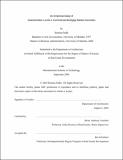An empirical study of subordination levels in commercial mortgage backed securities
Author(s)
Padhi, Romina
DownloadFull printable version (256.7Kb)
Alternative title
Subordination levels in CMBS
Other Contributors
Massachusetts Institute of Technology. Dept. of Architecture.
Advisor
Brian Anthony Ciochetti.
Terms of use
Metadata
Show full item recordAbstract
The CMBS market has been in existence since the mid 1980s; however, it was during the mid 1990s that the market began to grow. A combination of favorable interest rate environment, entry of new players in the market and the amount of demand for commercial real estate assets, led to a record US CMBS issuance in 2004, with the 2005 outlook being even better. However, the subordination or credit enhancement level of these securities has been on a downward trend since 1995. The thesis attempts to analyze the risk factors such as loan to value ratio, debt service coverage ratio, floating versus fixed rate, large and conduit deal types, as well as diversification factors (property type and geographic location), and their impact on subordination levels. Finally, market forces such as spreads on CMBS are also analyzed for their influence on subordination levels. For the analysis, data were collected on 430 commercial mortgage backed securities issued from 1995 through mid 2005. The information was obtained from Trepp, which tracks all the commercial mortgage backed securities issued in the market. The trend in subordination levels of each of the tranches or bond classes was analyzed over the period of study and a quantitative regression analysis was performed to analyze the influence of the above mentioned factors on the subordination levels. (cont.) The results indicate that the loan to value ratio, interest rate type (fixed versus floating) and the deal type (conduit and large loans) have a significant impact on the subordination levels. Also, certain other market factors, including the spread differential between CMBS and corporate bonds, strong property market performance, increased liquidity and increased number of investors may also have influence the subordination levels of these securities.
Description
Thesis (S.M.)--Massachusetts Institute of Technology, Dept. of Architecture, 2005. This electronic version was submitted by the student author. The certified thesis is available in the Institute Archives and Special Collections. Includes bibliographical references (leaves 50-52).
Date issued
2005Department
Massachusetts Institute of Technology. Department of ArchitecturePublisher
Massachusetts Institute of Technology
Keywords
Architecture.